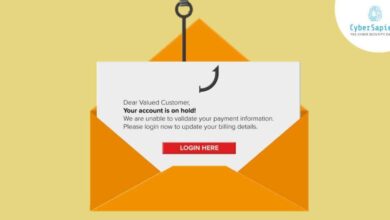
Beware of This Cadbury Easter Egg Cyber Fraud
Beware of this Cadbury Easter Egg cyber fraud! This year’s chocolate hunt might have a nasty surprise lurking online. Scammers are using fake Cadbury promotions to steal your personal information and money. Think you’re winning a free Easter egg extravaganza? Think again. Let’s dive into how to spot these scams and protect yourself from becoming a victim.
From cleverly disguised phishing emails to convincing fake websites, these cybercriminals are employing sophisticated tactics to trick unsuspecting chocolate lovers. We’ll explore the common red flags, the devastating consequences of falling prey to these scams, and most importantly, how you can safeguard yourself and your data this Easter.
Understanding the Scam: Beware Of This Cadbury Easter Egg Cyber Fraud

The Cadbury Easter egg cyber fraud is a sophisticated phishing scam preying on consumers’ excitement surrounding the Easter holiday and their desire to win prizes. These scams leverage the popularity of Cadbury chocolate and the allure of free or discounted goods to trick individuals into revealing personal information or making fraudulent payments. Understanding the mechanics of these scams is crucial to avoiding becoming a victim.The Mechanics of the Cadbury Easter Egg Cyber Fraud involve deceiving recipients into believing they’ve won a prize or are eligible for a special offer from Cadbury.
This is typically achieved through cleverly crafted emails, fake websites, or social media posts mimicking official Cadbury branding and messaging. The fraudsters then guide victims through a series of steps designed to extract sensitive data, such as credit card details, bank account information, or personal identifiers. These details are then used for identity theft, financial fraud, or other malicious purposes.
Targeting Methods
The fraudsters employ various methods to target potential victims. These include unsolicited emails appearing to be from Cadbury, often containing enticing subject lines like “You’ve Won a Cadbury Easter Egg Hamper!” or “Exclusive Cadbury Easter Offer!”. They might also utilize fake social media accounts or create websites that closely resemble the official Cadbury website, complete with logos and branding elements.
The goal is to create a sense of legitimacy and urgency to pressure victims into acting quickly without verifying the information’s authenticity.
Examples of Phishing Emails and Websites
A typical phishing email might contain a link to a fake website that looks identical to the official Cadbury website. This fake website requests personal information under the guise of prize claim or offer registration. The email might also contain attachments containing malware, designed to steal information from the victim’s computer. The fraudulent websites often have URLs that are very similar to the genuine Cadbury website, but with subtle differences, such as an extra character or a slightly altered domain name (e.g., cadbury-promo.com instead of cadbury.com).
These subtle changes are designed to fool unsuspecting users.
Characteristics of Fraudulent Cadbury Easter Egg Promotions
Several common characteristics distinguish fraudulent Cadbury promotions from legitimate ones. These include unusually high value prizes, requests for personal information upfront, pressure to act immediately, poor grammar and spelling in communication, and suspicious website addresses or email domains. Legitimate Cadbury promotions will never request sensitive information via email or through unverified websites.
Comparison of Legitimate and Fraudulent Promotions
| Promotion Type | Website Address | Contact Information | Prize Details |
|---|---|---|---|
| Legitimate Contest | cadbury.com (or a clearly identified official Cadbury promotional site) | Clearly displayed contact details, often linking to an official Cadbury customer service page. | Clearly defined prizes, with terms and conditions readily available. |
| Fraudulent Contest | Similar-looking domain, often with extra characters or slightly altered spelling (e.g., cadbury-promo.com). May use free web hosting services. | Often lacks clear contact information, or uses generic email addresses. | Exaggerated prizes, often with vague details or unclear terms and conditions. |
Identifying Red Flags
So, you’ve received an email or seen an online advertisement promising a free Cadbury Easter egg, or perhaps an extravagant prize linked to one. Before you get too excited, it’s crucial to know how to spot the warning signs of a scam. Many fraudulent schemes use enticing offers to lure unsuspecting victims, so a healthy dose of skepticism is your best defense.
Learning to identify these red flags can save you from disappointment and potential financial loss.This section will Artikel several key indicators that suggest a Cadbury Easter egg promotion is likely fraudulent. We’ll explore suspicious email addresses and websites, analyze unrealistic prize offers, and compare the language used in legitimate versus fraudulent communications. By understanding these characteristics, you can significantly reduce your risk of falling prey to these scams.
Suspicious Email Addresses and Website URLs
Fraudulent emails often use addresses that don’t align with Cadbury’s official domains. Look for misspellings, unusual characters, or domains that aren’t directly related to Cadbury (e.g., using free email services like Gmail or Yahoo instead of a Cadbury-branded address). Similarly, suspicious websites might have poorly designed layouts, grammatical errors, or URLs that seem slightly off. For example, a legitimate Cadbury website might be “www.cadbury.com/easter,” while a fraudulent one might be “www.cadbury-promo.net” or “www.cadburyeastergiveaway.xyz”.
Always double-check the URL against Cadbury’s official website to verify authenticity. A slight variation in spelling or an unfamiliar domain extension should immediately raise red flags.
Unrealistic Prize Offers
One of the most obvious red flags is an overly generous prize offer. If the promotion promises something too good to be true, it probably is. Think about it: would Cadbury realistically give away thousands of pounds worth of prizes to random people online without significant verification processes? Examples of unrealistic offers include incredibly high cash prizes, luxury cars, or exotic vacations with minimal effort required to claim the prize.
Legitimate contests often have clearly defined rules, participation limits, and realistic prizes.
Language Used in Communications
Legitimate companies maintain a professional and consistent tone in their communications. Fraudulent communications, on the other hand, often contain grammatical errors, typos, and informal language. They might use excessive exclamation points or overly enthusiastic language designed to pressure you into acting quickly. They may also employ a sense of urgency, claiming a limited-time offer or a rapidly expiring deadline to manipulate your decision-making.
Compare the language used in the email or website to the official Cadbury website’s communication style; the difference will be stark in fraudulent cases.
Warning Signs to Look For
It’s essential to be vigilant and look for several warning signs simultaneously. A single red flag might not always indicate a scam, but a combination of these signals strongly suggests fraudulent activity.
- Requests for personal information beyond what’s necessary for participation (e.g., bank account details, social security number).
- Suspicious email addresses or website URLs that don’t match Cadbury’s official domains.
- Unrealistic prize offers that seem too good to be true.
- Poorly written communication with grammatical errors and informal language.
- High-pressure tactics urging immediate action.
- Lack of transparency regarding rules and regulations.
- Requests for payment to claim a prize (legitimate contests rarely, if ever, require payment).
- Unusual or overly enthusiastic language.
Protecting Yourself

So, you’ve learned about the Cadbury Easter egg cyber fraud. Now, let’s focus on what you can do to stay safe. Protecting yourself from online scams requires vigilance and a proactive approach. Remember, prevention is always better than cure.This section Artikels practical steps you can take to avoid becoming a victim. We’ll cover verifying promotions, reporting suspicious activity, and maintaining strong online security practices.
By following these guidelines, you can significantly reduce your risk.
Verifying Online Promotions
Before clicking any link or entering personal information, always independently verify the authenticity of online promotions. Don’t rely solely on the information presented in the email or social media post. Go directly to the official Cadbury website. Look for the promotion on their official news or social media pages. Compare the details – the offer, the website address, and any contact information – with what’s on the official Cadbury site.
If there are discrepancies, it’s a major red flag. Remember, legitimate companies rarely use unsolicited emails or messages to offer significant prizes.
Reporting Suspicious Activity
If you encounter a suspicious Cadbury Easter egg promotion, report it immediately. Contact Cadbury directly through their official website or customer service channels. Report it to the relevant authorities in your country, such as your national cyber security agency or consumer protection agency. Reporting helps authorities track down scammers and prevent others from falling victim. Keeping records of the suspicious communication (emails, screenshots, etc.) will assist in the investigation.
Strong Password Practices and Secure Online Browsing, Beware of this cadbury easter egg cyber fraud
Strong passwords are your first line of defense against online threats. Use unique, complex passwords for all your online accounts. Avoid using easily guessable information like birthdays or pet names. Consider using a password manager to generate and store strong passwords securely. For secure online browsing, always ensure you are using a reputable and up-to-date web browser with enabled security features.
Be cautious about clicking links in unsolicited emails or messages. Only access websites through verified links from official sources.
Seriously, folks, be wary of those Cadbury Easter egg scams doing the rounds – they’re sneaky! I was just reading about secure app development, and it made me think about how much easier it would be to build robust security features into online transactions if more developers utilized the power of low-code platforms, like those discussed in this article on domino app dev the low code and pro code future.
Getting back to those dodgy Easter eggs, remember to always verify the sender before clicking any links!
Responding to Suspicious Cadbury Easter Egg Promotions
It’s crucial to have a clear plan of action when encountering a suspicious promotion. The following flowchart Artikels the steps you should take:
- Identify the Promotion: Carefully examine the email, message, or website. Note the sender’s details, the offer, and any requested information.
- Verify Authenticity: Visit the official Cadbury website and check for the promotion independently. Compare the details with the suspicious promotion.
- Check for Discrepancies: Look for inconsistencies in the website address, offer details, contact information, or any other information.
- Do Not Click Links or Provide Information: Avoid clicking any links or providing personal information, such as your name, address, or credit card details.
- Report the Suspicious Activity: Contact Cadbury directly and report the suspicious promotion to the relevant authorities.
- Change Passwords (If Necessary): If you’ve inadvertently provided any personal information, change your passwords immediately.
Impact and Consequences
Falling victim to a Cadbury Easter egg cyber fraud scam can have devastating consequences, extending far beyond the initial financial loss. The emotional toll, coupled with the potential for long-term damage to credit and reputation, underscores the severity of these crimes. Understanding the full impact helps in both prevention and recovery.The methods employed by scammers are designed to be deceptively simple, relying on the urgency and excitement surrounding the Easter holiday.
They often use phishing emails or fake websites mimicking legitimate Cadbury promotions. These platforms lure unsuspecting individuals into providing sensitive information under the guise of winning prizes or accessing exclusive offers.
Methods of Data Theft
Scammers utilize various tactics to obtain personal information. Phishing emails might contain malicious links leading to fake websites that mimic legitimate Cadbury pages. These sites often request personal details like full names, addresses, credit card numbers, and email addresses, all under the pretext of verifying eligibility for a prize. Sophisticated scams might even involve installing malware on victims’ computers, allowing the scammers to monitor online activity and steal data directly.
Financial Loss and Identity Theft
The immediate consequence is often financial loss. Scammers can use stolen credit card information to make unauthorized purchases, draining bank accounts and leaving victims with substantial debt. Beyond immediate financial impact, the stolen data can be used for identity theft. This can involve opening fraudulent accounts in the victim’s name, taking out loans, or even committing crimes under their identity.
The long-term repercussions of identity theft can be incredibly damaging, requiring extensive time and effort to rectify.
Types of Data Collected
The data collected by scammers can be incredibly comprehensive. This might include names, addresses, phone numbers, email addresses, dates of birth, social security numbers, credit card details, bank account information, and even driver’s license numbers. The more information they acquire, the more effectively they can impersonate the victim and commit further fraudulent activities. For example, they might use a victim’s address to file fraudulent tax returns or use their personal information to open new credit accounts.
Visual Representation of Impact
Imagine a three-panel infographic. The first panel depicts a happy family excitedly anticipating the arrival of their Cadbury Easter eggs. The second panel shows a stark contrast: the same family burdened by stress and worry, surrounded by bills and legal documents, representing the financial and emotional consequences of the scam. The third panel illustrates a shadowy figure – representing the scammer – holding a file overflowing with the family’s personal information, highlighting the theft and potential for long-term identity theft.
The overall visual progression demonstrates the drastic shift from joy and anticipation to anxiety and despair, showcasing the devastating consequences of this type of cyber fraud.
Reporting and Prevention
So, you’ve fallen victim to a Cadbury Easter egg cyber scam – what now? Don’t panic; taking swift action is key to minimizing the damage and potentially helping prevent others from suffering the same fate. Reporting the incident properly and understanding preventative measures are crucial steps in the recovery process.Reporting the fraud to the appropriate authorities is the first and most important step.
This helps law enforcement track down perpetrators, potentially recover losses, and prevent future scams. The process may vary slightly depending on your location, but generally involves gathering all relevant information, such as emails, screenshots, transaction details, and any communication with the scammers.
Reporting Cadbury Easter Egg Cyber Fraud to Law Enforcement
Begin by reporting the incident to your local police department. They will guide you through the process and potentially refer you to specialized cybercrime units. If the scam involved financial transactions, you should also contact your bank or credit card company immediately to report the fraudulent activity and potentially dispute the charges. Remember to keep detailed records of all communication and actions taken.
Consider filing a report with the Federal Trade Commission (FTC) in the US, or your country’s equivalent consumer protection agency. These agencies collect data on scams, helping identify trends and patterns that can inform future prevention strategies. For example, in the UK, Action Fraud is the national reporting centre for fraud and cybercrime.
Resources for Victims of Online Scams
Several resources are available to support victims of online scams. Many consumer protection agencies offer guidance, advice, and support services. Websites like the FTC’s website (in the US) provide detailed information on recognizing and avoiding scams, as well as reporting mechanisms. Additionally, victim support groups and charities can offer emotional and practical support during this difficult time.
These organizations often provide counseling, legal advice, and assistance with financial recovery. Remember, you’re not alone, and seeking help is a sign of strength, not weakness.
Preventative Measures for Companies
Cadbury and other companies can implement several measures to mitigate the risk of similar scams. Strengthening their online security measures is paramount, including robust authentication processes and secure payment gateways. Regular security audits and penetration testing can help identify vulnerabilities before they are exploited by scammers. Proactive measures like educating consumers about common scams through targeted advertising campaigns and clear warnings on official websites are crucial.
Cadbury could, for instance, issue press releases or social media posts highlighting the scam and advising consumers on how to avoid it. This proactive approach can significantly reduce the impact of future scams.
The Role of Cybersecurity Awareness Campaigns
Cybersecurity awareness campaigns play a vital role in combating online scams. These campaigns educate the public on common scams, red flags to watch out for, and best practices for online safety. By raising public awareness, these campaigns empower individuals to protect themselves from becoming victims. Effective campaigns use clear, concise messaging and accessible platforms to reach a wide audience.
They can be run through social media, television, radio, and partnerships with community organizations. For example, a campaign could use relatable scenarios and simple graphics to illustrate how scams work and what steps to take to avoid them.
Organizations and Websites for Reporting Fraud
Several organizations and websites accept reports of online fraud. These include:
- Federal Trade Commission (FTC)
– United States - Action Fraud – United Kingdom
- Your local police department
- Your bank or credit card company
- National Cyber Security Centre (NCSC)
-United Kingdom
It is crucial to report the incident to as many relevant organizations as possible to maximize the chances of apprehending the perpetrators and preventing future scams. Remember to keep detailed records of all communications and actions taken.
Conclusive Thoughts

This Easter, let’s enjoy the chocolate without the cyber stress. Remember, a little vigilance goes a long way in protecting yourself from online scams. By understanding the tactics used by fraudsters and taking proactive steps to verify online promotions, you can enjoy a happy and secure Easter celebration. Don’t let the lure of free chocolate blind you to the potential dangers lurking online – stay safe and happy hunting!
FAQ Corner
What should I do if I think I’ve already fallen victim to this scam?
Immediately change your passwords, monitor your bank accounts and credit reports for unusual activity, and report the scam to the appropriate authorities and Cadbury directly.
Are these scams only targeting people in specific locations?
While some scams might target specific regions, these types of online scams are often global, reaching potential victims across many countries.
How can Cadbury help prevent these scams from happening?
Cadbury can improve its cybersecurity measures, increase public awareness campaigns about their official promotions, and actively work with law enforcement to track down and prosecute scammers.
What types of personal information are scammers after?
Scammers aim to obtain anything that can be used for identity theft or financial gain, including your name, address, email, phone number, banking details, and social security number.





